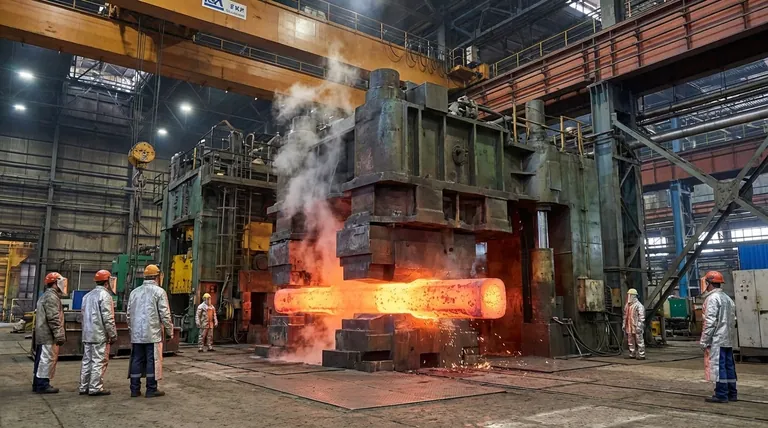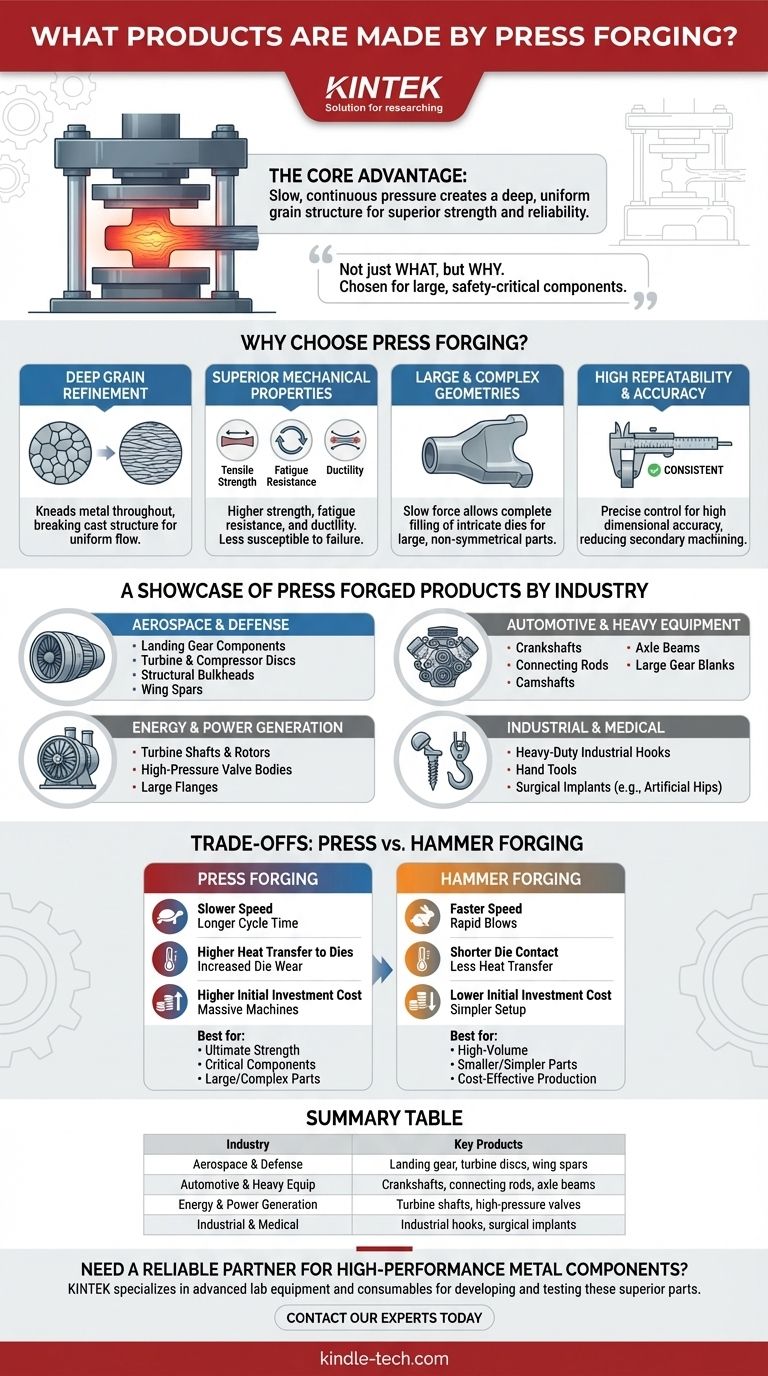Press forging is the manufacturing process behind many of the most critical, high-strength metal components used in modern industry. This method is chosen when exceptional internal strength and fatigue resistance are non-negotiable, producing parts ranging from aircraft landing gear and engine crankshafts to massive turbine discs for power generation.
The key takeaway is not just what is made by press forging, but why. This process is specifically selected for large, safety-critical components because its slow, continuous pressure creates a deep, uniform grain structure that is impossible to achieve with other methods, resulting in superior strength and reliability.

Why Choose Press Forging? The Core Advantages
Press forging isn't just an alternative to casting or machining; it's a specialized process chosen for its unique ability to enhance a material's fundamental properties. The decision to use it is driven by the need for ultimate performance.
Deep and Uniform Grain Refinement
Unlike hammer forging, which uses high-velocity impacts, press forging applies slow, controlled pressure. This action "kneads" the metal throughout its entire volume.
This process breaks down the coarse, cast grain structure of the initial billet and forces the formation of a fine, uniform grain flow that follows the component's shape.
Superior Mechanical Properties
This refined grain structure directly translates to exceptional mechanical characteristics. Press-forged parts exhibit higher tensile strength, fatigue resistance, and ductility.
Because the internal structure is so sound, these components are far less susceptible to failure under cyclical stress, making them ideal for parts that move, rotate, or endure constant loads.
Suitability for Large and Complex Geometries
The slow application of force gives the heated metal time to flow and completely fill intricate die cavities.
This makes press forging the preferred method for producing very large, non-symmetrical parts that would be difficult or impossible to form with the rapid blows of a hammer.
High Repeatability and Dimensional Accuracy
Modern hydraulic and mechanical presses offer precise control over pressure and stroke distance. This results in high dimensional accuracy from one part to the next.
This consistency reduces the need for extensive secondary machining, saving time and material, although some finishing is almost always required.
A Showcase of Press Forged Products by Industry
The applications for press forging are found where performance and safety are paramount. The list of products is a testament to the process's ability to create reliable, high-stress components.
Aerospace and Defense
This sector relies heavily on press forging for "flight-critical" components where failure is not an option.
Examples include landing gear components, structural bulkheads, wing spars, and the turbine and compressor discs found at the heart of every jet engine.
Automotive and Heavy Equipment
In the automotive world, press forging is used for components that must withstand the constant stresses of engine operation and vehicle movement.
Key products are crankshafts, connecting rods, camshafts, axle beams, and large gear blanks for transmissions and industrial machinery.
Energy and Power Generation
The extreme temperatures and pressures in power plants demand components with a high degree of material integrity.
Press forging is used to create turbine shafts and rotors, high-pressure valve bodies, and large flanges for oil and gas pipelines.
Industrial and Medical Applications
The process also finds use in other specialized fields. Large industrial hooks, heavy-duty hand tools, and even high-strength surgical implants like artificial hips are often produced via press forging to ensure durability and biocompatibility.
Understanding the Trade-offs: Press vs. Hammer Forging
While powerful, press forging is not the universal solution. Its selection involves clear trade-offs against other forging methods, primarily hammer (or drop) forging.
Process Speed and Cycle Time
Press forging is a slower process. The ram moves at a lower velocity, and each press cycle takes longer than the series of rapid blows used in hammer forging.
This can make it less suitable for very high-volume production of smaller, simpler parts where speed is the primary cost driver.
Heat Transfer and Die Life
The dies in a forging press are in contact with the hot workpiece for a much longer duration. This extended contact allows more heat to transfer from the part to the tooling.
This can lead to increased die wear and requires more robust (and expensive) die materials, representing a significant operational cost.
Initial Investment Cost
Hydraulic and mechanical forging presses, especially those capable of exerting tens of thousands of tons of force, are massive and incredibly expensive machines.
The capital investment required for a large press forging operation is significantly higher than that for a comparable hammer forging setup.
Making the Right Forging Choice
Selecting the correct forging process depends entirely on the technical and commercial requirements of the final product.
- If your primary focus is ultimate internal strength and fatigue life for a critical component: Press forging is the superior choice due to its ability to achieve deep, uniform grain refinement.
- If your primary focus is cost-effective production of smaller, simpler parts in high volumes: Hammer forging is often faster and involves a lower initial investment, making it more economical.
- If your primary focus is producing a massive, complex part with the best possible mechanical properties: Press forging is the definitive method, particularly for aerospace, energy, and heavy industrial applications.
Ultimately, choosing press forging is a strategic decision to prioritize a component's internal integrity and performance above all other considerations.
Summary Table:
| Industry | Key Press Forged Products |
|---|---|
| Aerospace & Defense | Landing gear, turbine discs, wing spars, bulkheads |
| Automotive & Heavy Equipment | Crankshafts, connecting rods, axle beams, gear blanks |
| Energy & Power Generation | Turbine shafts, high-pressure valves, pipeline flanges |
| Industrial & Medical | Industrial hooks, heavy-duty tools, surgical implants |
Need a reliable partner for high-performance metal components?
Press forging is the definitive method for achieving the ultimate strength, fatigue resistance, and reliability required in safety-critical applications. At KINTEK, we specialize in providing the advanced lab equipment and consumables necessary for developing and testing these superior components.
Whether you are in R&D, quality control, or production, our solutions support the entire lifecycle of high-integrity forged parts. Let's discuss how we can enhance your capabilities—contact our experts today to find the right equipment for your needs.
Visual Guide

Related Products
- Laboratory Hydraulic Press Lab Pellet Press Machine for Glove Box
- Laboratory Hydraulic Press Lab Pellet Press for Button Battery
- Manual High Temperature Heated Hydraulic Press Machine with Heated Plates for Lab
- Automatic High Temperature Heated Hydraulic Press Machine with Heated Plates for Lab
- Heated Hydraulic Press Machine with Heated Plates for Vacuum Box Laboratory Hot Press
People Also Ask
- What is KBr disc method? A Complete Guide to IR Spectroscopy Sample Prep
- What is an example of a hydraulic press? Discover the Power of Laboratory Sample Preparation
- What is the hydraulic forging process? Master the Art of High-Strength Metal Forming
- How much pressure can a hydraulic press make? From 1 Ton to 75,000+ Tons of Force
- Which one of the following is used to prepare sample pellet in IR spectroscopy? Potassium Bromide (KBr) Explained



















